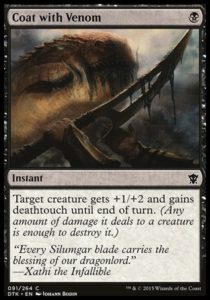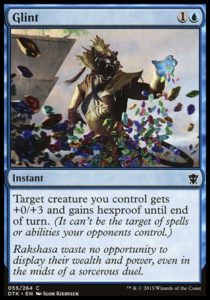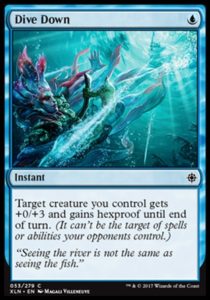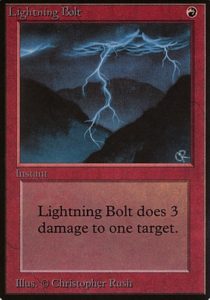This week we’re back with another deep dive onthe design of a specific card. This time we’re talking combat tricks, and specifically the Ixalan standout Dive Down.
Rise of the Trick
Several years ago, Dragons of Tarkir intoduced an innocuous-looking but surprisingly powerful combat trick in Coat with Venom. It was one of the turning points in flexible combat tricks, doing quite a lot with very little text: it provided just enough toughness for a creature to be able to survive combat or a damage-based removal spell, a tiny bit of power to push in damage, and the ability to kill anything. It combined disgustingly well with Atarka Efreet, giving it even more subtle utility.

Combat tricks have steadily been getting better over the years. They have gotten more flexible, as Coat with Venom is, more focused and powerful, as Built to Smash is, or provided additional advantage, as Strength of Arms does. But this isn’t all of the story—they also exist in a very different context. Let’s consider a more forgettable card from Dragons of Tarkir, Glint.

A Glint of Greatness
Glint is vastly inferior to Coat with Venom—it can’t push through damage and it doesn’t help take down creatures. It’s a purely defensive spell, only allowing a creature to survive combat or a removal spell. Worst of all, it costs two mana, which is much more difficult to hold up than one. Well, what happens when you knock off a mana?

Context is Key
Dive Down is shockingly potent in Ixalan Limited. It has all the problems of Glint, but far more advantages than its cheaper cost suggests. The reason for Dive Down‘s power is the format itself:
Speed. Ixalan is a fast Limited format, which rewards mana efficiency and relevant plays in the early turns.
Size. Creatures often have square power and toughness or greater power than toughness. Creatures also tend to be small in size. Consequently, Dive Down usually allows creatures to survive a trade, effectively turning it into a removal spell.
Slow Removal. Much of Ixalan’s removal is sorcery speed. This empowers combat tricks by reducing the risk of getting two-for-oned by a removal spell in response. Furthermore, few combat tricks provide a benefit greater than +2/+2 (and Crash the Ramparts is quite expensive), so a combat trick in response is unlikely to kill your creature.
Expensive Removal. Ixalan’s removal is expensive. Spending one mana to Negate a Contract Killing or Run Aground is a massive tempo play. Your opponent wastes their whole turn, while you can spend all but one mana.
Protection. Buffs like One With the Wind, Mark of the Vampire, and Pirate`s Cutlass are very strong. Dive Down allows you to protect your investment.
Miscellaneous Utility. There are several powerful abilities which Dive Down uniquely confounds. Territorial Hammerskull, Steadfast Armasaur, and Fathom Fleet Cutthroat are a few examples.

A New Paradigm
Normally, Dive Down would be a last pick card. Blue is generally among the least aggressive colors, making it poorly suited to exploiting Dive Down, except that’s not true here. The peculiarities of Ixalan transformed an unexciting combat trick into a powerful role-player. In Amonkhet, Dive Down would rarely have enabled a creature to win and survive combat. In Hour of Devastation, the slower format wouldn’t reward such a focused trick. In Aether Revolt, instant-speed removal would punish it more often. The wonderful lesson is just how much context plays a role in card evaluation, and that even unassuming cards can be powerhouses when the right conditions align.
At a PPTQ this past weekend, I won all but one game where I cast Dive Down, and it was often the deciding factor when I did win—either by letting me stop my opponent’s removal from getting them back into the game or by letting me kill a two drop and play a second two drop on turn three. When I had it in hand, I felt as safe as I do when I have Counterspell in cube. When it was on the other side of the table, I lost every game where it was cast against me, always because it was stopping a Run Aground or Pious Interdiction.
I knew to respect Dive Down before this event, but the experience really hammered home just how good it is. Induction is a powerful tool for understanding cards, but sometimes a small tweak to a card and its context can change an unplayable into something much, much greater.
And, as always, thanks for reading.
—Zachary Barash
Zachary Barash is a New York City-based game designer. He works for Kingdom Death: Monster, has an MFA in Game Design from NYU, and does freelance game design.
His favorite card of the month is Moment of Heroism. This unassuming little pump spell looks lackluster (after all, we get +2/+2 combat tricks with upside for W these days), but it can lead to complete blowouts in combat, where you kill a creature and gain 3-5 life for only two mana. It was particularly good in Innistrad, where instant-speed removal was weak and the (second) best deck in the format was an aggro deck overloaded on two drops. Sometimes, you just cast it to gain 5 life and flip the race on your opponent. It’s a delightfully simple card that beginners can understand, but it has powerful enough upside that skilled players can seek to maximize its effectiveness (while also siding it out when it’s irrelevant). That’s a whole lot to pack into a common combat trick with only two lines of text.

